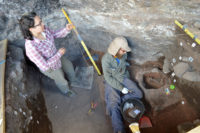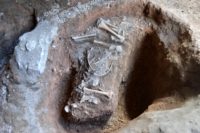 Archaeologists have discovered the skeletal remains of a prehistoric infant in Ciudad de Mendoza, western Argentina. Researchers from the Natural Science Department of the National University of Cuyo discovered the bones unexpectedly when looking for the sterile layer of a previous dig in the archaeological region known as the Niño de las Cuevas (the child of the caves). It was given that moniker after the remains of a young child between three and five years old at time of death were found there in 2015. That’s the excavation the University of Cuyo was following up on when they encountered the bones of a second child in the same archaeological layer as and just a few feet away from the first.
Archaeologists have discovered the skeletal remains of a prehistoric infant in Ciudad de Mendoza, western Argentina. Researchers from the Natural Science Department of the National University of Cuyo discovered the bones unexpectedly when looking for the sterile layer of a previous dig in the archaeological region known as the Niño de las Cuevas (the child of the caves). It was given that moniker after the remains of a young child between three and five years old at time of death were found there in 2015. That’s the excavation the University of Cuyo was following up on when they encountered the bones of a second child in the same archaeological layer as and just a few feet away from the first.
The team unearthed a circle of carbonaceous sediment whose black color and texture was markedly different from the reddish clay of the site. Researchers first thought it was part of a hearth, so the excavation proceeded in a different manner than over the rest of the grid, with thin, delicate tools like brushes instead of more aggressive digging tools. After removing an inch of sediment, they found fragments of a tiny jaw. The dimensions made it clear that this was the jaw of an infant.
When the burial was cleared, the full funerary structure was revealed, a circle just under a foot wide with the remains placed inside on the red clay layer. Because it was found at the same archaeological layer as the child discovered in 2015, it’s likely to date to around the same time: 5,750 years ago. The latest discovery is smaller, however, so died younger.
 The dig began less than two weeks ago on December 10th. One team member is still clearing the burial. Materials and remains will be analyzed and catalogued by the Human Paleoecology Laboratory. The bones of the infant will be radiocarbon tested so we know their age from direct examination. Stable isotope analysis will also be performed to discover where the child was from. Researchers will also attempt to determine the baby’s age, gender and cause of death.
The dig began less than two weeks ago on December 10th. One team member is still clearing the burial. Materials and remains will be analyzed and catalogued by the Human Paleoecology Laboratory. The bones of the infant will be radiocarbon tested so we know their age from direct examination. Stable isotope analysis will also be performed to discover where the child was from. Researchers will also attempt to determine the baby’s age, gender and cause of death.
Until the beginning of these studies there was only archaeological information related to the period of Inca domination (especially on a sacrifice of a child that was deposited in a high sanctuary located in the Aconcagua). Finding a skeleton was not expected by the group, since very few human skeletal remains had been discovered in high altitude environments. The result of the radiocarbon dating done on a fragment of one of its bones by AMS was also a surprise. The date obtained gives this individual an age of 5750 years. It is the oldest in the province of Mendoza and corresponds to a period in which the climatic conditions were more favorable to the current ones (a little warmer and wetter) in the mountain range according to pollen studies.
The regional archaeological information allows us to propose that the society from which this individual came had a hunter-gatherer economy and a band-like social organization. Surely it was small groups (between 30 and 50 people) that moved throughout the year, from lowlands to highlands and vice versa, to obtain the meat of animals that hunted (especially guanacos — Lama guanicoe) and vegetables that they collected.
“Having found this infant burial, it can be ascertained that it was the entire family group that moved (men, women and children) and that it is likely that the mountain range where it was left was part of a larger territory, a space of seasonal occupation to which it recurred,” said [anthropologist Víctor] Durán. Knowing where these ancient mountaineers came from and specifying aspects of their way of life is one of the major challenges of the research group. This new finding will allow expanding the ongoing studies that have placed the town of Las Cuevas in a position of great importance within the Archeology of the province and the country.”
Sorry, can’t resist…
Were “Bones of 5,750-year-old baby found in Argentina” or were “5,750-year-old bones of a baby found in Argentina”? 🙂